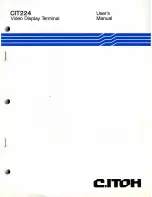
1275T / 1285T Series
Digital Clock Display
OPERATION
Revision 1.0
Page - 13
4.3.3. Setting the Time Daylight Saving Time Rules
Daylight Saving Time (DST) or Summer Time as it is called in many countries, is a way of getting more
daylight out of the summer days by advancing the clocks by one hour during the summer. Then, the
sun will appear to rise one hour later in the morning when people are usually asleep anyway, at the
benefit of one hour longer evenings when awake. The sunset and sunrise are one hour later than
during normal time.
To make DST work, the clocks have to be adjusted one hour ahead when DST begins, and adjusted
back one hour to standard time when DST ends. There are many countries observing DST, and many
who do not. Some countries adjust the clocks by two hours for DST.
During the months March/April to September/October, the countries in the Northern Hemisphere are
having their summer and may observe DST, while the countries in the Southern Hemisphere are having
winter. During the rest of the year (September/October to March/April) the countries in the Southern
Hemisphere are having their summer and may observe DST, while the countries in the Northern
Hemisphere are having winter.
Daylight Saving Time is difficult to predict, as many countries change the transition days/principles
every year because of special happenings or conditions that have happened or will happen.
How does the transition to DST start?
Let's say that DST starts at 2:00 am local time and DST is one hour ahead of standard time:
DST Start Transition
Local time
HH:MM:SS
DST or normal?
Comments
01:59:58
Normal
01:59:59
Normal
03:00:00
DST
DST started, time advanced by one hour
03:00:01
DST
03:00:02
DST
Table 4-1: DST Start Transition
Note that local time is never between 2:00:00 - 2:59:59. At the transition from standard time to DST,
this hour is skipped and therefore this day has only 23 hours (instead of 24 hours).
















































